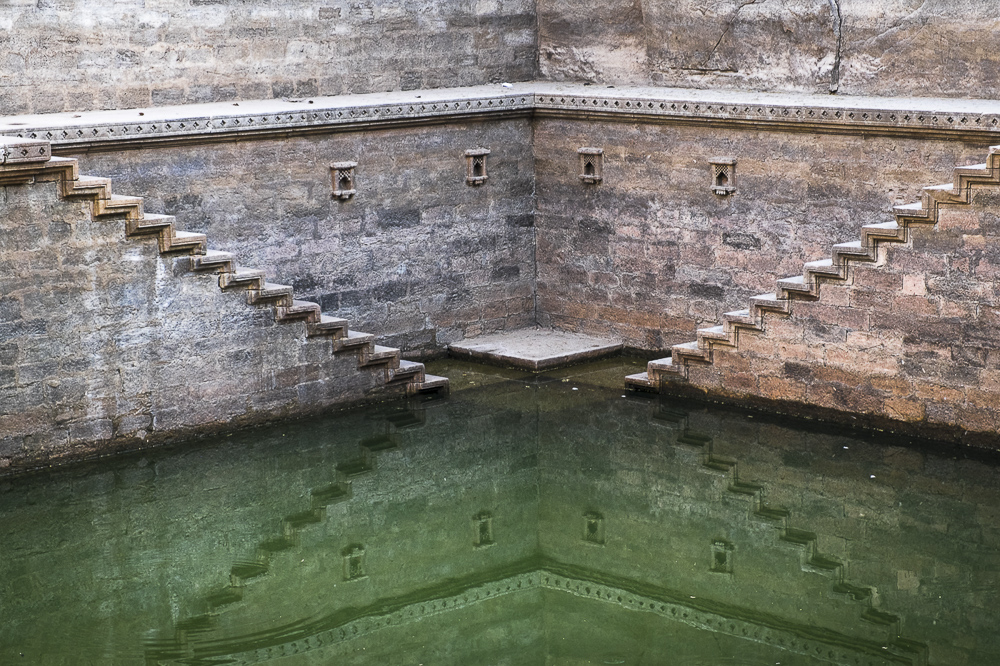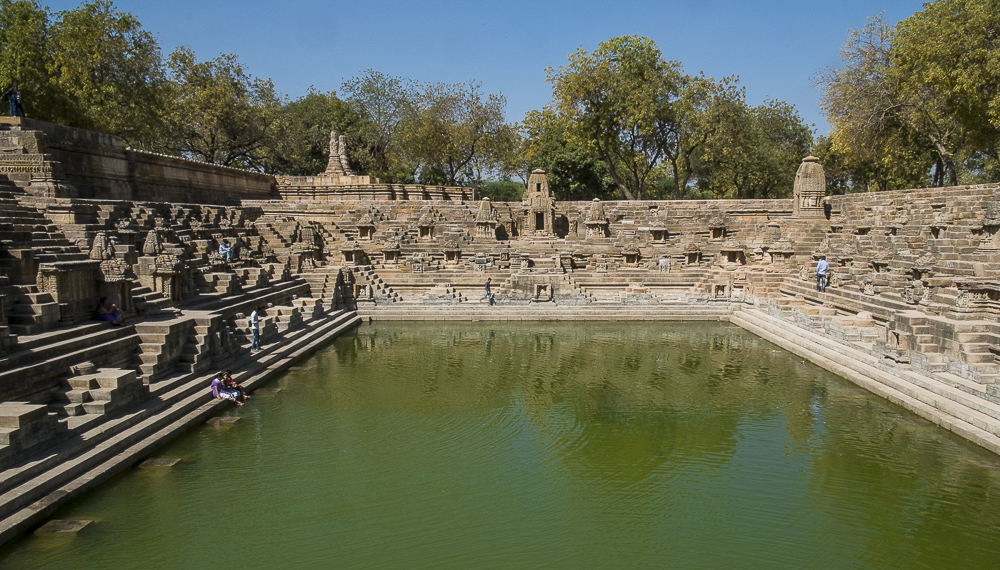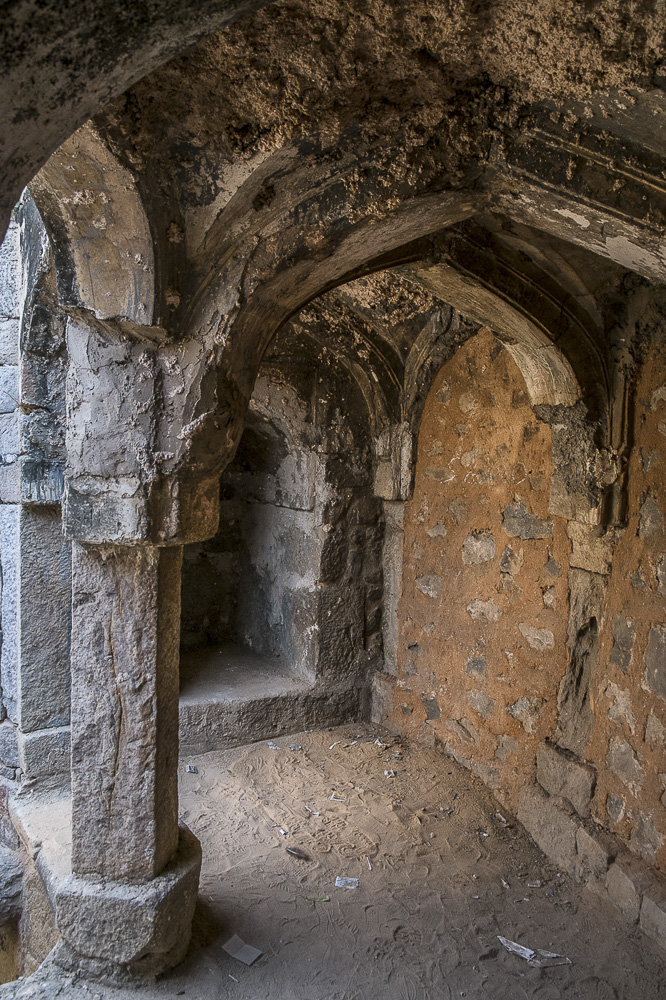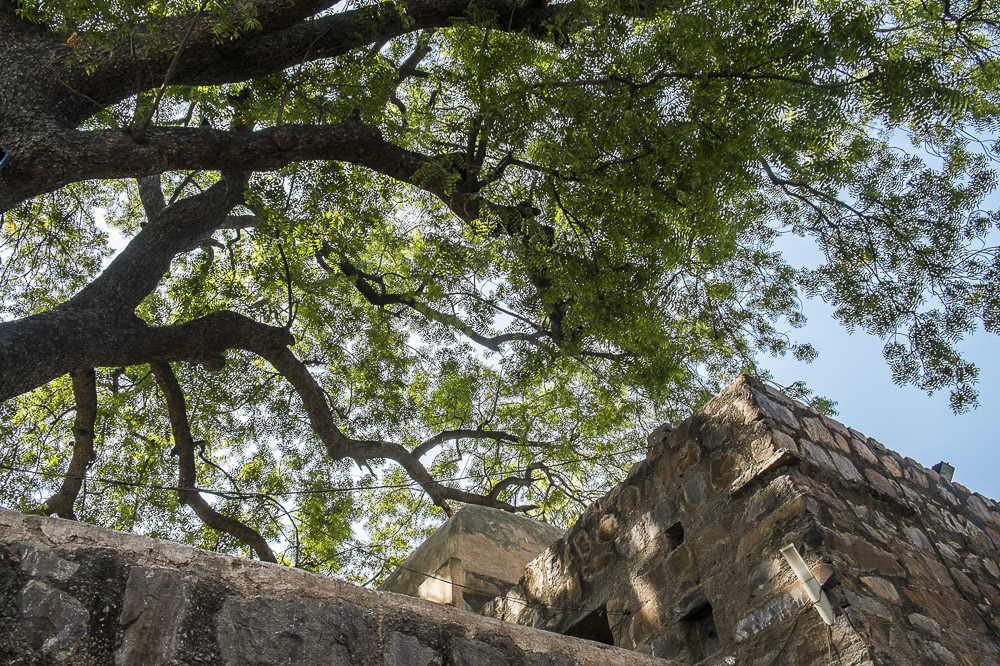About the names of stepwells: in Hindi speaking areas, stepwells are known as bawdi bawri, baoli or baori. In Gujarat they are usually called vav.
Part I: 2016
TOOR JI KI BAORI - JODHPUR, RAJASTHAN
The first stepwell we visit in 2016 is in Jodhpur, Rajasthan. I ask around for “Toor Ji ki Baori“, but the name seems unfamiliar to the locals, who, it turns out, know it as “Jahlara”. It is only a short walk from our hotel, but few tourists seem to wander away from Jodhpur’s famous fort and other major attractions. In contrast to the clock tower in the market square nearby, the stepwell is not visible from afar. You walk in the winding alleys of Jodhpur’s Blue City and suddenly, the ground opens up, confronting you with an upside-down ziggurat, dug into the earth - instead of reaching up to the heavens.
Sets of seven steps go down - one set to the right and one to the left, descending to the next platform, from where you step down to a new landing that is further in - and the next set of stairs starts to go down on each side. The pattern is repeated horizontally and vertically on three walls of the structure, so that a continuous, hypnotic rhythm is formed by these large blocks of stone seen in profile, and you are not certain if you are descending or ascending - as in an etching by Escher.
The water in the pool looks remarkably clean, in fact, I can see, even from afar, that it is teeming with fish, small and very large ones. With no fence around it, no locked gates, no guards, no visitors’ fees, the local community, serving ritual purposes to this day, keeps the Jhalara in Jodhpur clean with pride. An old man with a shiny metal bucket goes down slowly towards the water that is spurting out, from a corner of the stepwell, near the bottom - pure water, needed for the puja ceremony he is conducting in one of the pavilions above.
I stand there in silence, going down a few steps at a time. Then I start to photograph profusely, as if in a trance. The water, a luscious blue, deep down the steps, mesmerizes me, beckons me. It is the focal point of the entire structure. It calls you to follow the rhythm of the steps – as if playing the keys of a piano with your feet. You must, inevitably, go down, all the way down, to fulfill the stepwell’s promise.
I do not dare go all the way down. Closer to the water, the steps look slippery, covered with wet, green algae, and I feel vulnerable to be down there alone, a foreign woman in a strange land. To come so close to the water, so near its sources, and not to go all the way, leaves me with a sense of missing out on a singular experience.
*
In my web search, I had found two more stepwells in Jodhpur, but nobody seems to have heard about them. The name of one, “Bhoot Baori” makes people chuckle uncomfortably, as apparently it means “ghost” stepwell. We finally find an enterprising young rickshaw driver, Pardip, who says he knows some stepwells, if not the ones on my list.
First, I ask Pardip to accompany me down into the first well, the Jhalara. Indeed, the last few steps are so slippery that I need to hold his hand, so as not to fall into the water with my camera and all.
A sense of quiet, mingled with the coolness of being so close to the water, so deep in the ground overtakes me. It is the pleasure of going all the way down, to swim in the waters of my subconscious. It is an inner sense of completion.
MAHILA BAG JHALRA - JODHPUR, RAJASTHAN
Nearby, Pardip shows us a well that is almost an exact copy of the Jhalara, but much smaller, like a toy model of it. Here, there are sets of three steps instead of seven, not counting the landings above and below. Little domed pavilions mark the four corners of the structure, their slim pillars punctuating the rhythm of the Esher-like steps, echoed by equidistant pigeons on the wires. There is something more playful, lighter here, which, on the other hand, also lessens the urgency to go down.
On the fourth side is a central structure, where the cylindrical well that feeds the pool is housed. This structure is much more open than the one in the Jahlara, which seems like a fortress, hermetically closed with a concrete wall that must have been added as a physical support. Here, the “well-tower” has several large openings, so that the visceral focus of this stepwell is less on the pool itself, than on the enormous bottom orifice - a gaping mouth, gulping down the water of the pool – while conversely, it is the cylindrical well, hidden in that structure, from which the water originates..
TAPI KI BAORI – JODHPUR, RAJASTHAN
In his motorized rickshaw, Pardip drives us to the other end of town, to a stepwell known as Tapi ki Baori. It is locked behind a gate and our young driver gets the key in the shop next door. I ask how he knows this old, abandoned well, and he tells us that he would go swimming there with his friends as a boy, especially when the pools were full, during the hot monsoon months.
The place feels old and abandoned, as if from another era. Its red sandstone blocks are worn and wrinkled. A huge tree had fallen, long ago, across the steps that take up the entire breadth of the narrow space, enclosed on two sides by high walls of the adjacent buildings. You have to bend down under the bare trunk to reach a covered landing. Here, the roots of another tree scale the walls, growing into the stones, like the trees in Angor Wat, Cambodia, that smother hidden temples in the jungle.
Past the landing, the broad steps continue down, drowning into the blue-green waters of the first pool. On each side of the pool, the narrow ledges lead you to a second covered pavilion, where you are confronted with yet another pool. At its far end, the pool is closed off by a wall, mirrored in the water, with pitch-dark openings on each of its two stories. The third appears to be flooded, underwater.
The architectural thrust of this stepwell is less to go down towards the water – the steps are slow and low - than to penetrate further in, to find out what lies behind that wall. But here the ledges along the pool are crumbling, it is no longer possible to walk on them - you cannot reach the heart of the construction. Its mysteries remain unsolved, its fluttering ghosts are not disturbed. Only the pigeons know what is there.
RAM KUND - BHUJ, GUJARAT
Ram Kund, the stepwell in Bhuj, is near the center of town, but again, few people know where to find it. It is a perfect square, with sets of steps going down, and up, on all four sides. Here too, the flights of stairs are in mirror image of each other, one to the left and one to the right. The stairways are longer – with fourteen steps each, twice as many as the Jhalara, but there are fewer levels, so that the Ram Kund is a rather shallow stepwell.
The pool looks clean, a bit greener than the rich, velvety blue of the Jhalara, though not from algae. It is encircled by low buildings with gardens, trees that are reflected in its waters and an L-shaped passage in the low wall on the street side keeps out the cows that wander freely in the streets of Bhuj, as in other Indian towns. On one side is a little Hindu chapel, and niches with relics and pictures of Hindu deities decorate the walls. It is more a place of quiet contemplation, rather one that invites a dive into the subconscious.
The steps going down from each side of the platforms are reflected in the green water, forming diamond shapes. After returning home, I come across a photo of Ram Kund on the internet where the water of the pool is much, much lower. I am amazed to see that an entirely new level of stairs is now revealed, making the exact same diamond shapes as the reflections I photographed. In other words, the reflections turn out to be a ghost image of the actual, submerged stairs.
RANI KI VAV - PATAN, GUJARAT
Compared to the stepwells we had to search for in Rajasthan, Rani ki Vav – the Queen’s Stepwell - is a major landmark and signs announcing it line the road, as we approach the small town of Patan, in the Eastern part of Gujarat. Patan, famous for its intricate patola double icat weaving, is a part of our quest for Gujarati textile arts, the initial purpose of our journey. I was delighted to discover in my research, that it also prides itself on this unique stepwell.
We visit the well on a Sunday, the day of rest in India, accompanied by the teenage twins of our gracious homestay hosts, who are proud to show us their heritage as well as to practice their English. Families, couples, older people, stream into this beautifully designed park, all wearing their best clothes – women in colorful saris and older men in white tunics, the younger generation in more modern outfits. Doreen and I seem to be among the few western travelers, if not the only ones and we are overwhelmed by Indian tourists asking to be photographed together with us – here we are the exotic ones.
Rani ki Vav, dating from the eleventh century, is much more grandiose and many stories deeper than all the other wells we have seen. More than eight hundred remarkably well preserved stone sculptures and reliefs grace its walls, columns and ceilings, portraying historical figures, Hindu gods and goddesses, but also patterns of patola weaving, that reveal the antiquity of that art form.
A broad staircase at one end of the elongated structure leads down to the first of many platforms. Then the steps are broken down into small sets, running to the left and to the right, to yet another set of steps, on to the next roofed pavilion, and again more small flights of stairs on each side take you further down and down. Until you reach a wooden railing and the downward thrust is thwarted by the apparent need to regulate the flow of visitors. You cannot get to the pool down below, a pool that is now dry, or to the bottom of the well-tower, which is thirty meters deep and decorated with sculptures on its inner surface, some of them visible when I peer down the depths of the well, standing outside, at street level.
Rani ki Vav, the Queen’s Well, was commissioned by queen Udayamati, in memory of her husband, King Bhimadeva I of the Solanki dynasty, who died in 1064. It was considered a pious act to make water available to the entire community in these dry regions, earning the builders merit (punya) - both on the social and spiritual level.
The Queen’s Well is an inverted subterranean temple, a clear example of a negative space that has been unearthed a second time, after the nearby river that feeds its well had silted it, not long after its completion – as if the mud had filled up the stepwell’s mold. This silting and the stepwell’s excavation only a few decades ago account for the high degree of preservation of its sculptures.
As I wrote in my prologue, there is definitely a female element in these architectural structures. In essence a void, not ‘something to be seen’, stepwells are not visible from afar – unlike phallic towers and monuments erected by generally male rulers. Still they have a palpable presence. It is interesting to note that twenty-five percent of the people who commissioned stepwells for the public good were women, and that many of these wells are dedicated to the goddess Durga in her different manifestations.
The stepwell is also literally a women’s place – as women are the ones who traditionally fetch water. It must be quite an effort to carry heavy buckets of water all the way up those stairs – but the shaded pavilions provide a much appreciated opportunity for rest and socializing, breaking up the women’s often arduous daily routine.
SURIYA KUND - MODHERA, GUJARAT
At Modhera, a town not far from Patan, we visit Suriya Kund, a stepwell that lies just below the Sun Temple and forms an integral part of that complex. It is still Sunday, a beautiful day. Here too we encounter crowds of local visitors, and again, very few foreign tourists.
The Sun Temple was built in the year 1026, during the reign of the same Solanki king whose queen commissioned Rani ki Vav after his death, and it too is elaborately decorated with sculptural elements. Small and large shrines of gods and goddesses are placed among the steps on each level down to the pool – one hundred and eight shrines in all – an auspicious number in Hinduism.
There is no need for an elaborate structure to house the well that feeds the pool, as it lies submerged at its bottom, so that the pool can be surrounded by symmetrically repeated steps on all four sides. The rhythmic playfulness in these steps surpasses all we have seen earlier. Short and long flights of stairs alternate between sideways and frontal steps, while each flight of steps is echoed by another parallel, but slightly indented set, creating alternating squares of light and shadow, perhaps suggesting the intricate patterns of patola weaving.
The large, rectangular pool exudes a sense of openness, inviting you to come and dip your feet into its waters. Indeed, it was built to provide ritual cleansing before praying in the Sun Temple and wide, ceremonial steps lead up from the pool to the temples. Festively dressed families sit on the lower ledges, relaxing their feet in the water, or stand on the small platforms that are just a few centimeters under the surface.
Earlier that morning at the home of the twins, their grandmother had shown us a photo of herself standing on such a platform. Despite our lack of a common language, I understood that visiting the Suriya Kund was a sacred act for her, like her pilgrimage to the Hindu temples in Nepal.
GANDHAK KI BAOLI - DELHI
In Delhi only one of the three stepwells on my list seems to be known. However, Ajay, our Delhi rickshaw driver does his inquiries and takes us to the Mehrauli archeological park, an hour away. We circle around the park several times, until we find the poorly marked entrance, and even then, there are few signs to the wells. One, Gandhak ki Baoli, is actually at the far end of the park, just outside the fence, at the edge of an impoverished neighborhood. Its gate is locked, because a neighborhood boy had recently drowned in its waters. We have to bribe the guard from the park to let us in.
It is a narrow pool, with a few broad steps to the water that is covered in a thick, green carpet of plant growth, with refuse floating on top. On each side is a broad ledge leading to the well structure, a platform held up by four columns rising from the water with dark spaces between them. That is where the well has to be, but the grimy green water covers whatever is left of it, and it fails to call me to explore.
Much later, I find photos of this well on the internet, and see that, unbeknownst to me, there are several more levels of this structure that were lying submerged in the murky waters.
RAJON KI BAOLI - DELHI
Rajon ki Boali, now inside the park, is more impressive. A steep set of stairs goes straight down three stories without any landings, to another dirty pool, also overgrown with algae. There is a striking Moslem influence at this well, with two arcades on the upper level flanking the pool, and shallow arches lining the lower two floors, that that lack all sculptural decoration. On one side, there is a domed pavilion and what looks like the remains of a mosque.
I do not go down, the dirty water is not inviting. Instead, I go up the narrow winding staircase with domed ceilings, inside the well structure, at the opposite end. There, at a railing, you can look down into the well.
It is a picturesque site - indeed, three photographers are photographing a bride in bright red and groom striking dramatic poses, while another crew is scouting the place for their own film. There are hardly any other visitors, perhaps a few couples finding a romantic spot in a deserted park. Again, there are no foreigners, besides us, though these stepwells are only a stone’s throw away from Qutub Minar that is thronged by tourists from all over the world.
UGRASEN KI BAOLI - DELHI
Ugrasen ki Boali is the better known of the three stepwells we see in Delhi, at least there are signs leading to it. A plaque outside its walls provides a few historical remarks and points to the mosque that is a part of the complex. Still, there are few visitors - a few couples and two or three European backpackers.
The most striking feature here is the steep staircase going five or six stories down, spanning the entire width of the structure. Like the stairway at Rajon ki Baoli, it, too, has no landings. There are one hundred and three steps enclosed between two long walls made of hewn stone and rubble, held together with reddish cement. At the far end, the structure is closed off by a narrow tower housing the well, with large openings, one on top of the other.
Here, the pull of the visceral architecture is down, into the earth. There is nothing to stop you, to divert your attention, to slow your descent. There are no sculptures, like at Rani ki Vav, no domed galleries and the arched niches on the sidewalls are shallow, with no decoration. There are no shaded pavilions inviting you to stop and rest. Your eyes remain focused on the well below, your body keeps moving down, down –with the walls towering above you.
The pool at the bottom of the stairs is empty. Through the bars of the locked gate in the well-tower, I can see that the well is completely dry, silted. Then I look above, and see the sky through a grate that prevents people from falling into this deep pit. I photograph, finally getting a view of a cylindrical well from below.
I sit at the lowest step, under the arch of the tower opening, and look up the long staircase. I imagine the women who must carry their buckets up these steps, with no pavilions where they can sit and rest on the way. A large, old tree at the very top provides shade to those who finally make it up.
Even though there is no clean, blue water in this pool, a peaceful calm prevails. The other visitors do not seem to come all the way down, they stop halfway - perhaps they are concerned about having to climb up again.
I am alone here, with the cooing doves, deep into the earth. In another world.
CONTINUE TO STAIRWAY TO WATER - PART II - NOVEMBER 2018 (see link below)


























